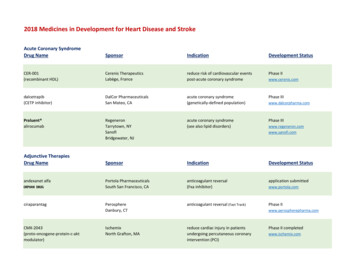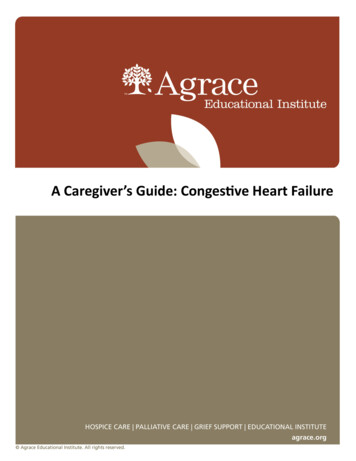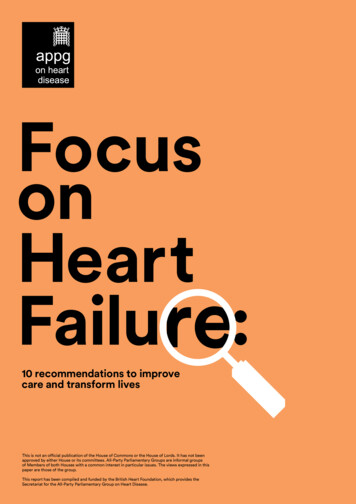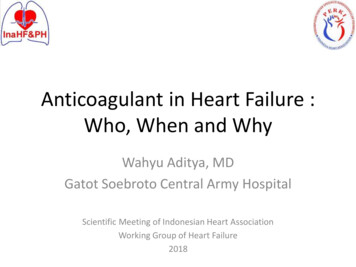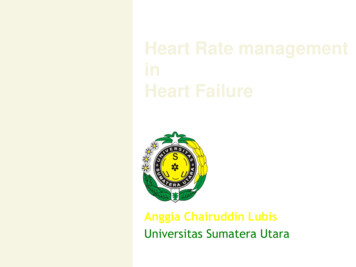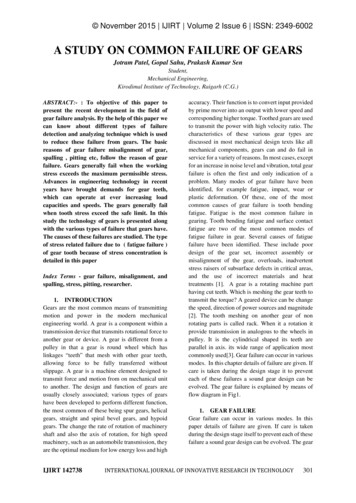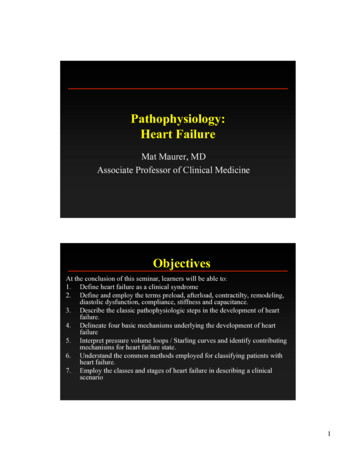
Transcription
Pathophysiology:Heart FailureMat Maurer, MDAssociate Professor of Clinical MedicineObjectivesAt the conclusion of this seminar, learners will be able to:1. Define heart failure as a clinical syndrome2. Define and employ the terms preload, afterload, contractilty, remodeling,diastolic dysfunction, compliance, stiffness and capacitance.3. Describe the classic pathophysiologic steps in the development of heartfailure.4. Delineate four basic mechanisms underlying the development of heartfailure5. Interpret pressure volume loops / Starling curves and identify contributingmechanisms for heart failure state.6. Understand the common methods employed for classifying patients withheart failure.7. Employ the classes and stages of heart failure in describing a clinicalscenario1
Heart Failure Not a disease A syndrome– From "syn“ meaning "together“ and "dromos"meaning "a running“.– A group of signs and symptoms that occur togetherand characterize a particular abnormality. Diverse etiologies Several mechanismsHeart Failure: Definitions An inability of the heart to pump blood at a sufficient rate tomeet the metabolic demands of the body (e.g. oxygen and cellnutrients) at rest and during effort or to do so only if the cardiacfilling pressures are abnormally high. A complex clinical syndrome characterized by abnormalities incardiac function and neurohormonal regulation, which areaccompanied by effort intolerance, fluid retention and areduced longevity A complex clinical syndrome that can result from anystructural or functional cardiac disorder that impairs the abilityof the ventricle to fill with or eject blood.2
Heart Failure Patients in the US(Millions)Epidemiology Heart Failure:The Problem 3.5 million in 1991, 4.7 millionin 2000, estimated 10 million in20371210 Incidence: 550,000 newcases/year86 Prevalence: 1% ages 50--59, 10% over age 804 More deaths from HF than fromall forms of cancer combined20199120002037 Most common cause forhospitalization in age 65Heart Failure Paradigms3
Heart Failure: ClassificationsCardiac vs.Non-cardiacRight vs. LeftSidedDilated vs.Hypertrophic vs.RestrcitiveSystolic vs. DiastolicCompensated vs.DecompensatedHeart FailureAcute vs. ChronicHigh vs. LowOutputForward vs.BackwardCardiac Muscle FunctionAfterloadbacMuscle Length (mm) The length of a cardiacmuscle fiber prior to theonset of contraction. Frank StarlingContractility norepinephrineb!La !LdTension (g)dTension (g)Tension (g)Preloadca dMuscle Length (mm) The force against whicha cardiac muscle fibermust shorten. Isotonic ContractionfbgeaMuscle Length (mm) The force of contractionindependent of preloadand afterload. Inotropic State4
From Muscle to ChamberSystoleDiastoleThe Pressure Volume Loop5
The Pressure Volume Stiffness vs CapacitanceLV Pressure (mmHg)25EDPVR2015Capacitance volume at specified pressure5Slope stiffness 1/compliance0-5“Diastolic Dysfunciton”5020406080100 120 140LV Volume (ml)LV Pressure 0250LV Volume (ml)6
Afterload (Arterial Properties)Ea (Arterial Elastance) If– TPR [MAP - CVP] / CO, and– CO SV * HR Substituting the second equation intothe first we obtain:– TPR [MAP - CVP] / (SV*HR) Making two simplifying assumptions.1. CVP is negligible compared toMAP.2. MAP is approximately equal to theend-systolic pressure in theventricle (Pes). Then,– TPR Pes / (SV*HR) Which can be rearranged to:– Pes/SV # TPR * HR.Cardiac Chamber FunctionPreload EDV EDP Wall stress at end diastoleAfterload Aortic Pressure Total peripheral resistance Arterial impedance Wall stress at end systoleContractility Pressure generated atgiven volume. Inotropic State7
HypotensionFrank Starling CurvesPulmonaryCongestionPathophysiology - PV Loop8
Pathophysiology of Heart FailureMyocardial Insult/Stimuli/DamagePump dysfunctionActivation of neurohormonesRemodeling Catecholamines Angiontensin II Cytokines Hypertrophy Fibrosis ApoptosisNeurohormonal Activation inHeart FailureMyocardial injury to the heart (CAD, HTN, CMP, valvular disease)Initial fall in LV performance, wall stressActivation of RAS and SNSRemodeling and progressiveworsening of LV functionFibrosis, s,myotoxicityMorbidity and mortalityArrhythmiasPump failureRAS, renin-angiotensin system; SNS, sympathetic nervous system.Peripheral vasoconstrictionSodium retentionHemodynamic alterationsHeart failure symptomsFatigueActivity alteredChest congestionEdemaShortness of breath9
Neurohormonal Activation inHeart FailureAngiotensin IINorepinephrineHypertrophy, apoptosis, ischemia,arrhythmias, remodeling, fibrosisMorbidity and MortalityAdrenergic Pathway in HeartFailure Progression CNS sympathetic outflow Vascular sympathetic activity Cardiac sympathetic activity&1&2%1Myocyte hypertrophyMyocyte injuryIncreased arrhythmias Renal sympathetic activity%1Vasoconstriction&1Activationof RAS%1Sodium retentionDisease progression10
Neurohormonal Balance inHeart FailureNeurohormones in Heart FailureFall in LV PerformanceMyocardial InjuryActivation of RAAS and SNS(endothelin, AVP, cytokines)ANPBNPMyocardial ToxicityChange in Gene ExpressionMorbidity and MortalityRemodeling andProgressiveWorsening ofLV FunctionPeripheral VasoconstrictionSodium/Water RetentionHF SymptomsShah M et al. Rev Cardiovasc Med. 2001;2(suppl 2):S211
Pathophyisiology of myocardial remodeling:Insult / RemodelingStimuli ! Wall Stress Cytokines Neurohormones Oxidative stressIncreased Wall StressMyocyte HypertrophyAltered interstitial matrixFetal Gene ExpressionAltered calcium handlingproteinsMyocyte tolicDysfunctionAcute and Chronic Responses –Benefits and HarmResponseShort-term Effects(mainly adaptive;hemorrhage, acute heartfailure)Long-term Effects(mainly deleterious;chronic heart failure)Salt and water retentionAugments preloadPulmonary congestion, anasarcaVasoconstrictionMaintains pressure for perfusion ofvital organs (brain, heart)Exacerbates pump dysfunction,increases cardiac energy expenditureSympathetic stimulationIncreases heart rate and ejectionIncreases energy expenditureCytokine activationVasodilatationSkeletal muscle catabolism,deterioration of endothelial function,impaired contraction, LV remodeling.HypertrophyUnloads individual muscle fibersDeterioration and death of cardiaccells: cardiomyopathy of overloadIncreased collagenMay reduce dilatationImpairs relaxation12
Laplace’s LawhWhere P ventricular pressure, r ventricular chamberradius and h ventricular wall thicknessRemodeling – Concentric vs. Eccentric13
Ventricular RemodelingPathophysiology of Heart FailureFour Basic Mechanisms1. Increased Blood Volume (Excessive Preload)2. Increased Resistant to Blood Flow (ExcessiveAfterload)3. Decreased contractility4. Decreased Filling14
Increased Blood VolumeAorticRegurgitationAI NeurohormonesVentricularRemodelingNa RetentionVasoconstrictionEtiologies Mitral Regurgitation Aortic Regurgitation Volume Overload Left to Right Shunts Chronic Kidney DiseaseAI RemodelingNormalAIAI NeuroHormonesAI Remodeling140/75128/50130/50104/45SV (ml)64808263Cardiac Output (L/min)3.83.04.32.6PCWP (mm Hg)10152520ParameterBP (mm Hg)Increased AfterloadHypertensionHTN DD EaDiastolicDysfunctionEtiologies Aortic Stenosis Aortic Coarctation HypertensionHTN DD HFNa RetentionVasoconstrictionRemodelingNormalHTNHTN DDHTN Heart failure131/76150/100140/92161/105SV (ml)57524957Cardiac Output (L/min)4.03.63.44.0PCWP (mm Hg)10101323ParameterBP (mm Hg)15
Decreased ContractilityMIMI RemodelingMI Heart FailureVentricularRemodelingNa RetentionVasoconstrictionEtiologies Ischemic Cardiomyopathy– Myocardial Infarction– Myocardial Ischemia Myocarditis Toxins– Anthracycline– Alcohol– CocaineParameterMI MI 44SV (ml)60424646Cardiac Output (L/min)4.23.03.23.2PCWP (mm Hg)12172523BP (mm Hg)Decreased FillingNormalHCMVentricularRemodelingEtiologies Mitral Stenosis Constriction Restrictive Cardiomypoathy Cardiac Tamponade HypertrophicCardiomyopathy Infiltrative CardiomyopathyHCM HFNa RetentionVasoconstrictionParameterNormalHCMHCM HF124/8195/47105/53SV (ml)635055Cardiac Output (L/min)4.43.53.8PCWP (mm Hg)101726BP (mm Hg)16
Part IIHeart Failure: ClassificationsRight vs. LeftSidedDilated vs.Hypertrophic vs.RestrcitiveAcute vs. ChronicCardiac vs.Non-cardiacHeart FailureForward vs.BackwardSystolic vs. DiastolicCompensated vs.DecompensatedHigh vs. LowOutput17
Types of Heart FailurePathophysiologySHFDiastolicImpaired ContractionImpaired fillingAll ages 60 yearsCoronary Artery DiseaseHypertensionDemographics1 CauseSystolic Versus Diastolic alVolumePressurePressurePressure" ContractilityVolume" CapacitanceVolume18
Systolic Versus Diastolic FailureHeart Failure: ClassificationsRight vs. LeftSidedDilated vs.Hypertrophic vs.RestrcitiveAcute vs. ChronicCardiac vs.Non-cardiacHeart FailureForward vs.BackwardSystolic vs. DiastolicCompensated vs.DecompensatedHigh vs. LowOutput19
Decompensated Heart FailureHeart Failure: ClassificationsRight vs. LeftSidedDilated vs.Hypertrophic vs.RestrictiveAcute vs. ChronicCardiac vs.Non-cardiacHeart FailureForward vs.BackwardSystolic vs. DiastolicCompensated vs.DecompensatedHigh vs. LowOutput20
High vs. Low Output Failure nemiaSystemic arteriovenous fistulasHyperthyroidismBeriberi heart diseasePaget disease of boneGlomerulonephritisPolycythemia veraCarcinoid syndromeObesityAnemiaMultiple myelomaPregnancyCor pulmonalePolycythemia veraHeart Failure: ClassificationsRight vs. LeftSidedDilated vs.Hypertrophic vs.RestrictiveAcute vs. ChronicCardiac vs.Non-cardiacHeart FailureForward vs.BackwardSystolic vs. DiastolicCompensated vs.DecompensatedHigh vs. LowOutput21
Dilated vs. Hypertrophic vs. itionDilated left/bothventricle(s) with impairedcontractionLeft and/or rightventricular hypertrophyRestrictive filling andreduced diastolic fillingof one/both ventricles,Normal/near normalsystolic functionSample EtiologiesIschemic, idiopathic,familial, viral, alcoholic,toxic, valvularFamilial with autosomaldominant inheritanceIdiopathic, amyloidosis,endomyocardialfibrosisDilated vs. Hypertrophic vs. Restrictive22
Clinical Manifestations SymptomsReduced exercise toleranceShortness of breathCongestionFluid retentionDifficulty in sleepingWeight lossDiagnosis of heart failure Physical examinationChest X rayEKGEchocardiogramBlood tests: Na, BUN, Creatinine, BNPExercise testMRICardiac catheterization23
NYHA atient Symptoms No limitation of physical activityNo undue fatigue, palpitation or dyspneaSlight limitation of physical activityComfortable at restLess than ordinary activity results in fatigue,palpitation, or dyspnea Marked limitation of physical activity Comfortable at rest Less than ordinary activity results in fatigue,palpitation, or dyspnea Unable to carry out any physical activity withoutdiscomfort Symptoms of cardiac insufficiency at rest Physical activity causes increased discomfortACC/AHA Staging SystemSTAGE A High risk for developing HFSTAGE B Asymptomatic LV dysfunctionSTAGE C Past or current symptoms of HFSTAGE D End-stage HFHunt, et al. J Am Coll Cardiol. 2001; 38:2101-2113.24
ACC/AHA Staging SystemStageABCDPatient DescriptionHigh risk for Hypertensiondeveloping heart failure Coronary artery disease Diabetes mellitus Family history of cardiomyopathy Previous myocardial infarctionAsymptomatic heart Left ventricular systolic dysfunctionfailure Asymptomatic valvular disease Known structural heart diseaseSymptomatic heart Shortness of breath and fatiguefailure Reduced exercise tolerance Marked symptoms at rest despite maximalRefractorymedical therapy (e.g., those who are recurrentlyend-stage heart failurehospitalized or cannot be safely discharged fromthe hospital without specialized interventions)Goals of Treatment1. Identification and correction of underlyingcondition causing heart failure.2. Elimination of acute precipitating cause ofsymptoms.3. Modulation of neurohormonal response toprevent progression of disease.4. Improve long term survival.25
Etiologies Ischemic cardiomyopathyValvular cardiomyopathyHypertensive cardiomyopathy.Inflammatory cardiomyopathyMetabolic cardiomyopathyGeneral system diseaseMuscular dystrophies.Neuromuscular disorders.Sensitivity and toxic reactions.Peripartal cardiomyopathyPercipients /Associated Factors Inappropriate reduction in the intensity of treatment, including– Dietary sodium restriction,– Physical activity reduction,– Drug regimen reduction, or,– most commonly, a combination of these measures. Ischemia Hypertension Anemia Volume Overload Increased Metabolic Demand– Infection– Thyroid Disease Arrhythmia Asthma/COPD26
Targets of TreatmentStandard PharmacologicalTherapy ACE inhibitorsAngiotensin Receptor Blockers Beta Blcokers Diuretics Aldosterone Antagonists Statins Vasodilators InotropesTreatmentStageABCDPatient TreatmentHigh risk for Hypertensionpharmacologic therapy (OPT)developing heart failure OptimalCoronary artery disease Aspirin, ACE inhibitors, statins, b-blockers, a-b-blockersDiabetes mellitus(carvedilol) diabetic therapy Family history of cardiomyopathyPrevious myocardial infarctionAsymptomatic heart OPTLeftif ventricularsystolicdysfunction(systolic) ICDleft ventricular(LV) dysfunctionfailure presentAsymptomatic valvular diseaseKnown structural heart diseaseSymptomatic heart OPT ICDif LV dysfunction(systolic)presentShortnessof breath andfatiguefailure CRT(ifQRSwide,LVEF!35%)Reduced exercise toleranceMarked symptoms at rest despite maximalRefractory OPTIV inotropesmedical therapy(e.g., those who are recurrentlyend-stage heart failure Intermittent ICDasabridgetransplantationhospitalized ortocannotbe safely discharged from CRTthe hospital without specialized interventions) Other devices (LVAD, pericardial restraint)27
Treatment of Acute Heart FailureACC/AHA Staging System28
Summary Complex Clinical Syndrome Multiple Etiologies and Classification Systems Physiologic Understanding artsim/29
4. Delineate four basic mechanisms underlying the development of heart failure 5. Interpret pressure volume loops / Starling curves and identify contributing mechanisms for heart failure state. 6. Understand the common methods employed for classifying patients with heart failure. 7. Employ the classes and stages of heart failure in describing a .


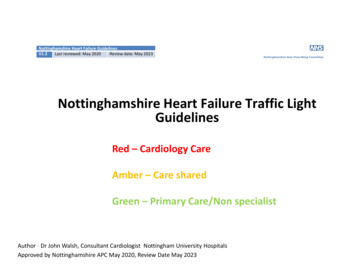
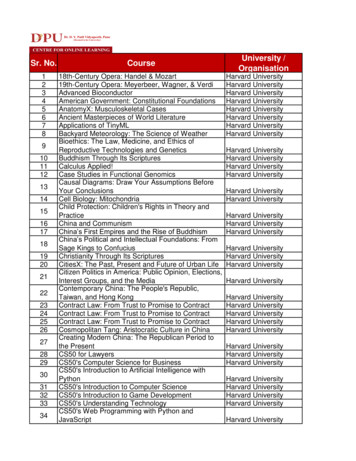
![Heart Failure Pathophysiology.ppt [Read-Only]](/img/29/card08-heartfailurebw.jpg)
